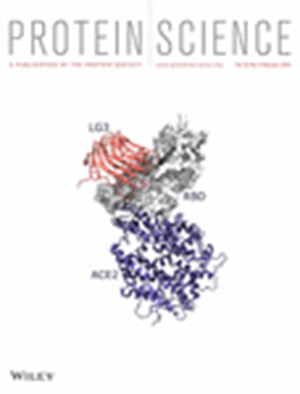BracketMaker:化学蛋白质合成的可视化和优化
IF 4.5
3区 生物学
Q1 BIOCHEMISTRY & MOLECULAR BIOLOGY
引用次数: 0
摘要
化学蛋白质合成(CPS)是一种日益流行的技术,它通过固相肽合成产生约 20-60 aa 的定制肽段,然后通过连续的连接反应将其拼接在一起。CPS 的工作流程通常用 "括号 "式的图表来描述,其中详细说明了起始肽段以及所有连接、脱硫和/或脱保护步骤的顺序,以获得产品蛋白质。括号是比较多种可能合成方法的宝贵工具,也是整个合成过程的蓝图。然而,手工或在标准图形软件中绘制 CPS 支架是一个费力且容易出错的过程。此外,CPS 领域缺乏标准的括号格式,因此很难进行并排比较。为了解决这些问题,我们开发了 BracketMaker,这是一个内置图形用户界面(GUI)的开源 Python 程序,用于快速创建和分析 CPS 支架。BracketMaker 包含一个自定义图形引擎,可将文本字符串(注释了反应步骤的蛋白质序列,此处将其作为括号的标准化格式)转换为高质量的矢量或 PNG 图像。为了帮助进行新的合成,BracketMaker 的 "AutoBracket "工具会自动对一组片段进行逆合成分析,利用标准的原生化学连接、保护和脱硫技术草拟并排列所有可能的连接顺序。AutoBracket 与我们之前报道过的自动 Ligator(Aligator)程序的改进版相结合,提供了一个为给定蛋白质序列快速制定合成计划的管道。我们展示了这两个程序在开发最小大肠杆菌核糖体 65 种蛋白质蓝图中的应用。本文章由计算机程序翻译,如有差异,请以英文原文为准。
BracketMaker: Visualization and optimization of chemical protein synthesis
Chemical protein synthesis (CPS), in which custom peptide segments of ~20–60 aa are produced by solid‐phase peptide synthesis and then stitched together through sequential ligation reactions, is an increasingly popular technique. The workflow of CPS is often depicted with a “bracket” style diagram detailing the starting segments and the order of all ligation, desulfurization, and/or deprotection steps to obtain the product protein. Brackets are invaluable tools for comparing multiple possible synthetic approaches and serve as blueprints throughout a synthesis. Drawing CPS brackets by hand or in standard graphics software, however, is a painstaking and error‐prone process. Furthermore, the CPS field lacks a standard bracket format, making side‐by‐side comparisons difficult. To address these problems, we developed BracketMaker, an open‐source Python program with built‐in graphic user interface (GUI) for the rapid creation and analysis of CPS brackets. BracketMaker contains a custom graphics engine which converts a text string (a protein sequence annotated with reaction steps, introduced herein as a standardized format for brackets) into a high‐quality vector or PNG image. To aid with new syntheses, BracketMaker's “AutoBracket” tool automatically performs retrosynthetic analysis on a set of segments to draft and rank all possible ligation orders using standard native chemical ligation, protection, and desulfurization techniques. AutoBracket, in conjunction with an improved version of our previously reported Automated Ligator (Aligator) program, provides a pipeline to rapidly develop synthesis plans for a given protein sequence. We demonstrate the application of both programs to develop a blueprint for 65 proteins of the minimal Escherichia coli ribosome.
求助全文
通过发布文献求助,成功后即可免费获取论文全文。
去求助
来源期刊

Protein Science
生物-生化与分子生物学
CiteScore
12.40
自引率
1.20%
发文量
246
审稿时长
1 months
期刊介绍:
Protein Science, the flagship journal of The Protein Society, is a publication that focuses on advancing fundamental knowledge in the field of protein molecules. The journal welcomes original reports and review articles that contribute to our understanding of protein function, structure, folding, design, and evolution.
Additionally, Protein Science encourages papers that explore the applications of protein science in various areas such as therapeutics, protein-based biomaterials, bionanotechnology, synthetic biology, and bioelectronics.
The journal accepts manuscript submissions in any suitable format for review, with the requirement of converting the manuscript to journal-style format only upon acceptance for publication.
Protein Science is indexed and abstracted in numerous databases, including the Agricultural & Environmental Science Database (ProQuest), Biological Science Database (ProQuest), CAS: Chemical Abstracts Service (ACS), Embase (Elsevier), Health & Medical Collection (ProQuest), Health Research Premium Collection (ProQuest), Materials Science & Engineering Database (ProQuest), MEDLINE/PubMed (NLM), Natural Science Collection (ProQuest), and SciTech Premium Collection (ProQuest).
 求助内容:
求助内容: 应助结果提醒方式:
应助结果提醒方式:


